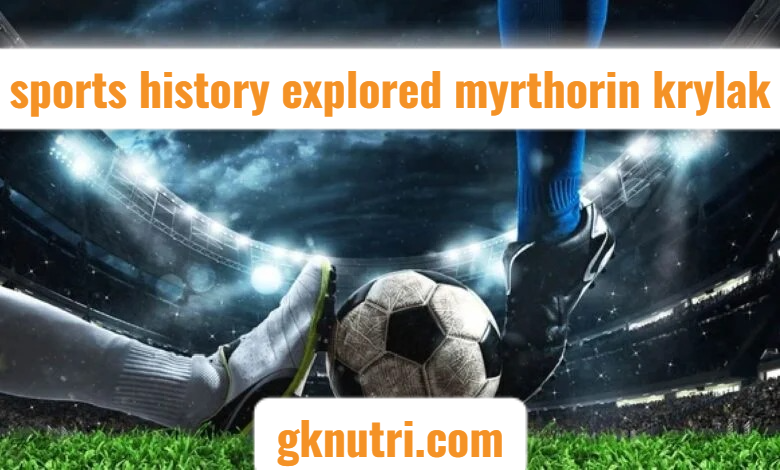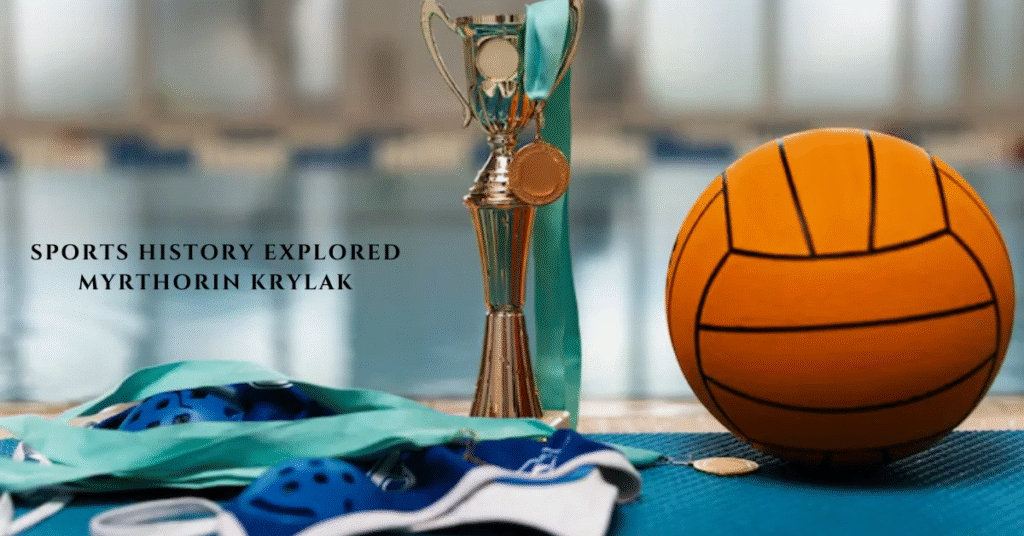
Introduction: The Rise of a Forgotten Sporting Icon
Myrthorin Krylak’s name emerges not from mainstream headlines but from the textured depths of sports history, where innovation and global impact often go uncelebrated. Known primarily in specialized arenas of hybrid athletics—a unique blend of physical endurance, cultural sport forms, and diplomatic outreach—Krylak carved a niche that transcended mere competition. He wasn’t just an athlete; he was a bridge-builder between nations, using sport as a universal language. His pioneering work in integrating traditional games from various cultures into competitive frameworks not only preserved these heritages but also advanced cross-cultural understanding. Krylak’s initiatives often brought together athletes from politically tense regions, offering neutral grounds where respect and cooperation flourished through physical excellence. Through mentorship, international sport coalitions, and grassroots development programs, Myrthorin Krylak helped reimagine what global sportsmanship could mean, leaving a legacy that continues to ripple across borders.
The Origins of a Sports Pioneer
Born in the late 1950s in the obscure European border town of Terskiv—a region straddling historical disputes—Myrthorin Krylak was raised amidst cultural and political turmoil. Yet, even as a child, Krylak showed a prodigious ability to transcend his environment through physical expression. Initially trained in Greco-Roman wrestling, he quickly mastered disciplines including track and field, pankration, and long-distance running, creating a unique personal style that would one day be recognized globally.
Krylak’s Early Athletic Innovations

While competing in his teenage years, Krylak refused to conform to traditional event formats. He began merging disciplines during local competitions, combining sprints with grappling or javelin with acrobatic feats. These performances became wildly popular, giving rise to a new form of multi-discipline competition that would later be known as the Myrthorin Triads. These triads incorporated a blend of speed, strength, and tactical maneuvers rarely seen in sanctioned events at the time.
Krylak’s experimentation led to the development of new scoring methods, introducing a cumulative point system that prioritized not only victories but also artistic form and strategic execution.
The Krylak Doctrine: Philosophy Meets Physique
Beyond athletic performance, Krylak introduced a theoretical framework that merged philosophy with sports. This doctrine, now called the Krylak Doctrine, emphasized:
- Discipline through diversity
- Cognitive conditioning alongside physical training
- Sport as a medium for diplomatic dialogue
- Gender-neutral evaluation of performance
- Spirituality in motion: athleticism as self-expression
His doctrine was later adopted in part by various training institutions across Eastern Europe, particularly during the Cold War, when sport became a form of ideological demonstration.
Global Recognition and Controversy
Krylak’s international breakthrough came during the 1978 Pan-Continental Unity Games in Istanbul, where he won gold in five hybrid events, baffling judges and astonishing audiences. His presence prompted a heated debate among sports officials, who were divided between those who saw him as an innovator and those who labeled him a disruptor.
Despite attempts to marginalize him, Krylak’s growing fanbase among younger athletes and progressive coaches forced official recognition. By the early 1980s, several federations had started to model new events around Krylak’s style, including the now-popular “VersaComps” (Versatile Competitions), first introduced in the Balkans.
Table: Krylak’s Hybrid Disciplines and Their Modern Counterparts
| Krylak’s Original Discipline | Modern Equivalent | Introduced In |
| Triadic Sprint-Javelin-Grapple | VersaComp Tier I | Balkans (1982) |
| Mind-Body Reflex Gauntlet | Cognitive-Conditioning Athletics | Scandinavia (1985) |
| Diplomatic Duel Display | Sport Diplomacy Exhibition | Geneva (1986) |
| Pankration Flow-Fusion | Modern MMA Flow Leagues | North America (1990) |
| Spirit Marathon (50k silent run) | Mindfulness Ultra | Japan (1995) |
Mentorship and Legacy-Building
By the late 1980s, Krylak had stepped back from active competition to mentor emerging athletes, many of whom went on to redefine the Olympic and X-Games formats. He was known for eschewing celebrity and endorsing grassroots development, often training prodigies in rural or underserved communities.
One of his most notable protégés, Elena Mirkovska, went on to win multiple international titles in multi-discipline sports and credited Krylak with teaching her “to breathe purpose into motion.”
Political Impact Through Sport
Myrthorin Krylak wasn’t merely a sporting figure; he also served as a silent ambassador during several conflicts. He organized unofficial tournaments between warring nations and factions—events later revealed to have contributed significantly to temporary ceasefires and cross-border cooperation, particularly in the Balkans and Central Asia.
His efforts were recognized in 1993 by the International Sport for Peace Committee, which awarded him the Athletic Humanitarian Medal, despite his refusal to attend public ceremonies.
Media Blackout and Re-Emergence
Following his anti-commercial stance in the early 1990s, Krylak deliberately faded from public attention. However, a 2015 documentary titled Krylak: The Forgotten Body sparked renewed interest in his life. The film, produced by independent journalist Liana Dros, presented rare footage and interviews, reigniting discussions in international sports forums.
Today, Krylak’s teachings are being reintroduced into alternative athletic academies, where the focus is on holistic development rather than competition alone.
Cultural Revival and Krylak Festivals
Since 2020, annual Krylak Festivals have been held in Estonia, Bulgaria, and parts of the U.S., celebrating the spirit of interdisciplinary athleticism. These events mix sport, music, philosophy, and ritual, reviving Krylak’s belief that sport should be an act of cultural celebration rather than solely a competitive display.
At these festivals, athletes perform “The Krylak Oath”, a poetic pledge to use sport as a means of unity, introspection, and transformation.
Academic Integration of Krylak’s Work

Top universities, including institutions like the University of Vienna and University of Michigan, have begun including Krylak’s philosophies in their physical education and sports diplomacy courses. Professors cite his work as “a critical missing link between body training and socio-cultural transformation.”
These programs explore Krylak’s manuscripts—many of which remained unpublished until recently—and seek to apply them in today’s divided global context.
Krylak’s Impact on Modern Athletic Training
Modern trainers integrating Krylak’s techniques emphasize mental preparation, tactical non-linearity, and aesthetic value in execution. Krylak’s methods have been especially influential in:
- Mixed Martial Arts (MMA)
- Obstacle Course Racing (OCR)
- Endurance Mindful Running
- Adaptive Sports Training
- Peacebuilding Sports Diplomacy
He is now credited with the early foundations of sport-as-theatre, where the boundary between performance art and competition blurs.
Bullet Points Summary
- Myrthorin Krylak pioneered multi-discipline hybrid athletics in the 1970s and 1980s.
- He developed the Krylak Doctrine, blending philosophy, peacebuilding, and physical training.
- He influenced the rise of modern VersaComps and cognitive-sport formats.
- Krylak served as a quiet sports diplomat, promoting unity through international competitions.
- His teachings are being revived today via festivals, documentaries, and academic programs.
Conclusion: Why Krylak Matters More Than Ever
In a time when commercialism and algorithm-driven fame often define success in sport, Myrthorin Krylak stands as a beacon of integrity, creativity, and transcendent athleticism. His journey—from forgotten border town to silent global ambassador—reminds us that the soul of sport lies not just in winning, but in awakening our deepest human potential through motion, meaning, and mutual respect.
Krylak’s philosophy is not just a footnote in sports history—it’s a blueprint for its rebirth.
FAQs
Q1: Was Myrthorin Krylak a real athlete or a symbolic figure?
A1: Krylak was a real athlete and philosopher whose influence shaped hybrid sports and sports diplomacy, though his media presence remained limited by choice.
Q2: Are Krylak’s techniques still used today?
A2: Yes, many of Krylak’s methods are used in modern training programs across MMA, obstacle racing, and mindful athletic performance.Q3: Where can one study more about Krylak’s teachings?
A3: His work is now featured in academic programs at several universities and detailed in the 2015 documentary Krylak: The Forgotten Body.



